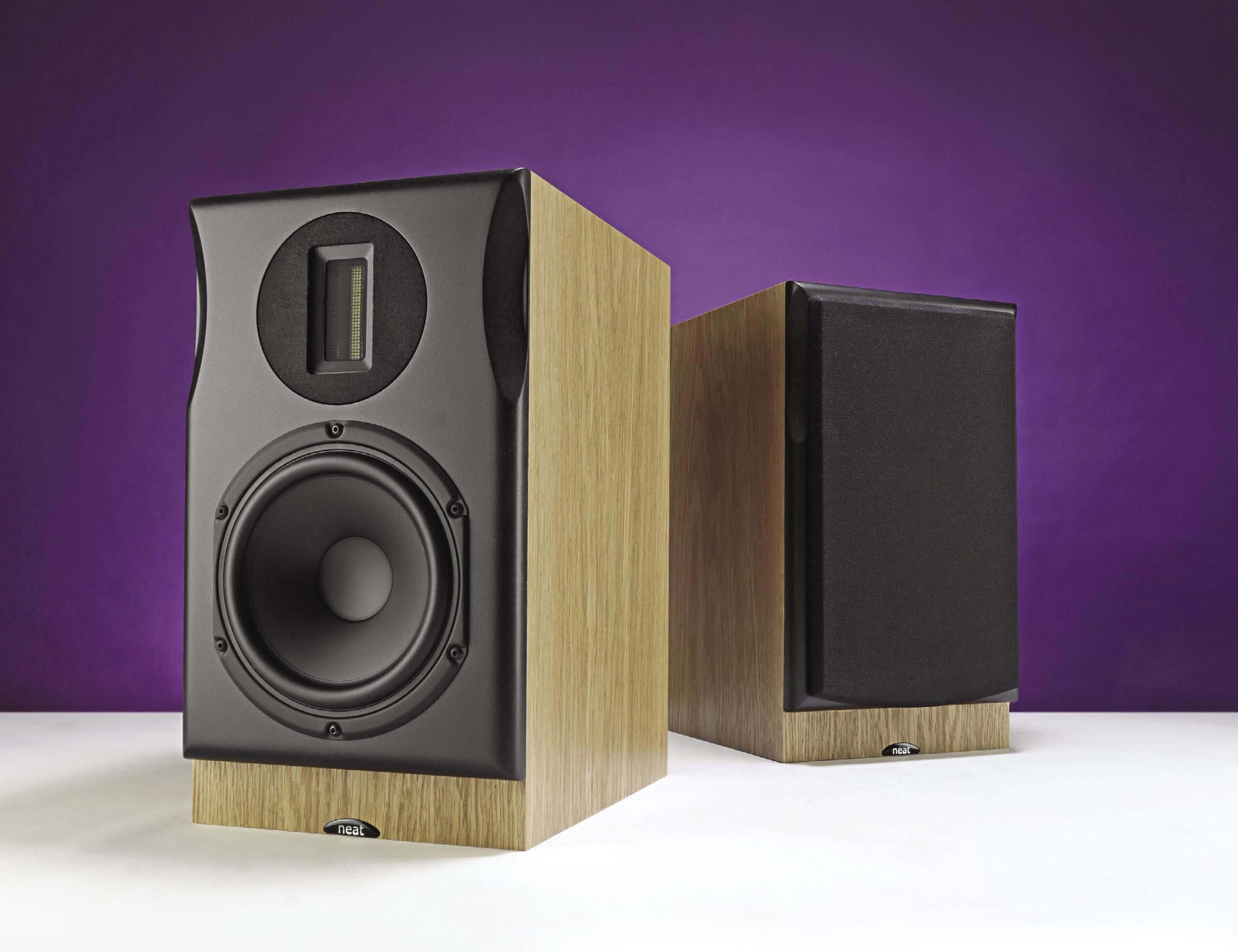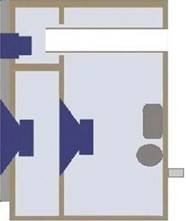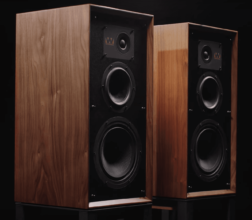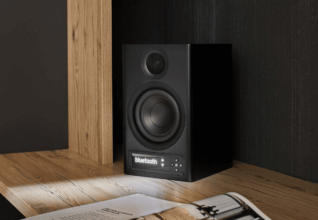NEAT MAJISTRA Review: Top Story
Fitted with a ribbon tweeter for top treble quality, NEAT’S new Majistra loudspeaker engages Noel Keywood. Read our NEAT MAJISTRA Review.
NEAT’s Majistra had me puzzled. The ribbon tweeter produced excessive treble under measurement, something I usually find aurally unacceptable. Review fear set in: I’d rather not sit there gritting my teeth. But in this case, the sonic picture wasn’t as expected – for much of the time, the Majistras sounded balanced and impressive, for reasons I’ll come to explain. So here is a curious review, one that is both good and bad: the Majistra turned out to be ‘fun’ in more ways than one. A top device in more ways than one.

The Majistra is a large standmounter, heavy at 11kg. It will go on a shelf, but this is not ideal as the speaker generates a lot of bass and would likely induce room boom in rooms under 16 feet long. With dimensions of 380mm high, 220mm wide, and 290mm (11.5in) deep, it will sit on a stand easily enough and, this way, can be maneuvered for best results. Cabinet finishes are black oak, satin white, natural oak, and American walnut, our review samples are visually light natural oak. Beneath the removable grilles, held by magnetic catches, lie two drive units, a 170mm treated paper cone bass unit, and – playing a starring role – a 60mm long ribbon tweeter that NEAT calls “a true ribbon” by which I guess they mean not a folded ribbon. Here comes my first aside.
Long ago (late ’80s), I heard and took to the Tonigen ribbon tweeter used in the Heybrook Sextet, a favorite loudspeaker of mine at the time. So I used it in World Audio Design’s first loudspeaker, KLSI. Integrating a ribbon isn’t so easy, technically, because they don’t run low and subjectively because an aluminum ribbon doesn’t sound like much else, leading to the chameleon character. The Sextet suffered this, but the benefit of a ribbon tweeter outweighed this disadvantage. You get super clean and precision fast treble that leaves domes standing – or so you might think.

After years in front of an electrostatic I now find ribbons have their colour, sounding tinselly, but this gives a good impression. Designers emphasize it by lifting output to ensure their contribution is obvious. No point in using an expensive drive unit if no one notices. Making them sonically more conspicuous than domes – especially in the Majistra.
Ribbon tweeters have progressed since the Tonigen. It reached 5kHz, but Neat’s decreased to 2kHz, contributing more to the sound. Ribbons have become popular in Germany, where companies like Quadral and Mundorf are associated. But Quadral loudspeakers, which I know well and greatly admire, follow a different design ethic to that of NEAT: they measure flat.
The Majistra differs in other ways. It uses the Isobaric loading of the bass unit to minimize pressure changes in the chamber behind. A second bass unit sits behind the main one, working into a vented rear chamber, with a vent (port) sited on the rear panel. It’s quite a lot to squeeze into a small cabinet, but it delivers “surprisingly deep and controlled bass,” NEAT says, something our measurements confirmed. Such loading raises cabinet and drive unit costs and, with two bass units to drive, lowers impedance and sensitivity. The Majistras need an amplifier with some oomph: think 60+ Watts.

SOUND QUALITY
Initially, I drove the Majistras from our Creek i20 amplifier (100W), believing its easygoing sound would be most suitable. Not so. It works well with acoustically well-damped loudspeakers where the bass is enhanced, like our Icon Audio Stereo 30 SE. Still, the Majistras have strong bass and need a grippy amplifier like our PrimaLuna EVO300 Hybrid with its 100W MOSFET output stage. Differences were large, with the PrimaLuna exerting better bass control.
Acting as a source was our Oppo UDP-205D silver disc player spinning CD and acting as an ES9038Pro equipped DAC to feed hi-res from a MacBook Pro, including DSD, from an Audirvana+ software player. For LP, I used our Timestep Evo modified Technics SL-1210 Mkll with SME309 arm and Audio Technica VM750 SH MM cartridge, feeding a Pro-Ject Phono Box RS2.
The Majistras proved a bit Jekyll and Hyde, as expected. Mostly, they came across as full-bodied with surprisingly powerful deep bass about cabinet size. This was more apparent with LP than the drier balance of CD, where the bass line in Ride Across the River (Brothers In Arms, Mobile Fidelity 45rpm re-master) was large and muscular, making it very apparent in the mix. Lows were very low, sending rumbling sounds out at me.

As this track faded and The Man’s Too Strong got into its stride, Mark Knopfler’s aggressive chord strikes flew at my ears in a supercharged fashion. Meanwhile, his vocals and all else were smoothly and evenly presented. It was only at specific moments when the music deviated from ‘normal’ that the Majistras suddenly jumped at me, both at the bass end and up top. In this sense, they are dramatic, that’s for sure, but I had reservations about such emphasis, where the balance I know suddenly became very different.
Spinning Alison Goldfrapp’s Supernature LP’s massive lows came from the synthesizer and suitably breathy vocals from the lady, laced with sibilance from lines like “switch me on, turn me up” (Ooh La La) where ‘s’ and ‘t’ shot out like needles. At times like this, the extreme treble of the tweeter was very apparent. Otherwise, the album came over well enough, sounding big-bodied and powerful.
“Spinning Alison Goldfrapp’s Supernature LP massive lows came from the synthesiser”
The same sort of switch from one state to another occurred with Nigel Kennedy playing Vivaldi’s Spring (CD), where the orchestra was clear and very detailed, and so was Nigel’s Stradivarius for the most part – until he got strenuous with the higher strings – then his violin was pushed hard at me and took on a sheeny edge. The tweeter gives superb quality and deep insight, making this a dramatic experience that seemingly shades all else – because it does shade all else! But I found the drama artificial, making a presentation quite different from what I know. It’s very easy in a situation like this to elect for drama and excitement, which the Majistras have in buckets, but the longer I listened, the more my reservations were built.
Running through a swathe of CDs and LPs, I noticed that the Majistras were, on balance, nothing other than a great experience. They deliver wonderfully clear vocals with both body and depth, with a sense of insight that betters most else; the ribbons were mining deep detail. The bass was strong and ran low, and the overall character of the loudspeaker was fulsome. There were times when I heard more from a song than ever before. However, a sense of bass and treble was emphasized as if a loudness control was in play.
MEASURED PERFORMANCE
Our frequency response analysis shows a dominant feature of the NEAT Majistra is rising output from the ribbon tweeter, from where it comes into play at 2kHz up to 20kHz where output is + 8dB above the 1kHz datum – a very large rise not seen in other loudspeakers. This result is with the grille on and 25 degrees off-axis. Ribbon tweeters have wide dispersion, so measuring on/off axis made little difference, and the grille was transparent, so it had no effect either.
Below 4kHz, output is even down to 400Hz, after which there is a low-frequency lift of +4dB down to 90Hz before output starts to fall away. Deep bass below 100Hz is aided by a well-damped port (red trace).
Emphasis on the lower mid-band suggests a full-bodied sound balance. Extension to 30Hz means very low bass ‘subsonics’ will be audible. Then, strong low bass and a full-bodied sound are shown here.
Sensitivity was low at 84dB sound pressure level (SPL) from one nominal Watt (2.8V) input, meaning 60W+ amplifiers will be needed. NEAT quote 88dB – not a figure we could repeat.
The two bass units combined come in at 3.5 Ohms d.c.r. overall, our impedance trace shows that impedance stays close to this value, up to 200Hz. The near-flat nature of the trace means the loudspeaker is well-damped acoustically, reflecting into being an almost resistive load. The port is tuned to 40Hz and its dip shows. The impedance measured with pink noise was a normal 6.5 Ohms due solely to the midband peak caused by voice coil and crossover inductances.
The Majistra has a reasonably flat response up to 4kHz, but above that, the strong treble rise will be audible. The bass runs very low and is strong.

VERDICT
The Majistra comes across as big-bodied and color-free with most recordings and music genres. As NEAT claims, they deliver bass with depth and weight. The ribbon tweeter mostly sounds finely detailed and fast, but at times, its rising output was very obvious. This is an idiosyncratic loudspeaker that is worth hearing if a strong bass and high treble are an attraction.
Neat Majistra - Product Video
In this video, Neat reveals their newest Loudspeaker to the Strata range, the Majistra alongside the Ministra, Ekstra, and Orkestra.






